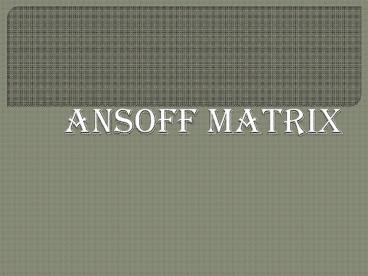Ansoff Matrix - PowerPoint PPT Presentation
1 / 25
Title:
Ansoff Matrix
Description:
Title: Ansoff Matrix Author: MR.LAZY Last modified by: MR.LAZY Created Date: 1/8/1980 10:44:01 PM Document presentation format: On-screen Show (4:3) – PowerPoint PPT presentation
Number of Views:1228
Avg rating:3.0/5.0
Title: Ansoff Matrix
1
Ansoff Matrix
2
Group Detail
- Group C
- Ahmed Najeeb (MM103014)
- Tabassum Riaz (MM103034)
- Sufyan Saeed (MM103053)
- Mustajab Khan (MM103075)
3
Introduction
- Igor Ansoff created the Product / Market diagram
in 1957 as a method to classify options for
business expansion. The simplicity of this model
is that the four strategic options defined can be
generically applied to any industry. - This well known marketing tool was first
published in the Harvard Business Review (1957)
in an article called Strategies for
Diversification. It was consequently published
in Ansoffs book on Corporate Strategy in 1965.
4
About the Ansoff Matrix
- It is used by marketers who have objectives for
growth. Igor Ansoffs matrix offers strategic
choices to achieve the objectives. There are four
main categories for selection. - Market Penetration
- Market Development
- Product Development
- Business Diversification
5
Variables in the matrix
- Two variables in Strategic marketing
- Decisions
- The market in which the firm was going to operate
- The product intended for sale
- In terms of the market, managers had two options
- Remain in the existing market
- Enter new ones
6
Variables in the matrix
- In terms of the product, the two options are
- selling existing products
- developing new ones
7
Ansoff Matrix
PRODUCT DEVELOPMENT Sell new products in
existing markets
MARKET EXTENSION Achieve higher sales/market
share of existing products in new markets
Diversification New Products in New Market
8
Improving the performance of existing businesses
- Improving the performance of existing businesses
- Do Nothing if the environment is static
(short-run only) - Withdraw when there is an irreversible decline
in demand or opportunity costs of staying in a
market are too high - Consolidation means concentration of resources
and focusing on existing competitive advantages - Penetration means gaining market share
9
MARKET PENETRATION
10
MARKET PENETRATION
- Here we market our existing products to our
existing customers - This is the objective of higher market share in
existing markets - E.g. in 2000, Mitsubishi announced a 10
reduction in prices in the UK in order to
encourage purchases
11
objectives
- Maintain or increase the market share of current
products - Secure dominance of growth markets
- Restructure a mature market by driving out
competitors - Increase usage by existing customers. For example
by introducing loyalty schemes.
12
Strategies
- Penetration Pricing
- Bundling
- Aggressive campaign
13
Market Development
MARKET EXTENSION Achieve higher sales/market
share of existing products in new markets
14
Market Development
- Here we market our existing product range in a
new market - Example Gourmet now Expand its business in
different cities( Faisalabad, Multan . etc) of
Pakistan but initially it was only in Lahore - Objective
- Increase Numbers of Customers
15
Strategies
- New geographical markets
- New product dimensions or packaging
- For Example
- New distribution channels
- Different pricing policies to attract different
customers or create new market segments
16
Product Development
PRODUCT DEVELOPMENT Sell new products in existing
markets
MARKET EXTENSION Achieve higher sales/market
share of existing products in new markets
17
Product Development
- This is a new product to be marketed to our
existing customers - (existing markets, new products)
- Least risky of all four strategies
- E.g. Coca-Cola. This has been developed to have
vanilla, lime, cherry and diet varieties (amongst
others) in the SOFT DRINKS market
18
Product Development
- Objective
- To Increase Number of Products
- Strategies
- Increase Product Line
- Product Line Stretching (Both Horizontally
Vertically)
19
Diversification
PRODUCT DEVELOPMENT Sell new products in existing
markets
MARKET EXTENSION Achieve higher sales/market
share of existing products in new markets
DIVERSIFICATION Sell new products in new markets
20
Diversification
- (new markets, new products)
- This is a new product to be marketed to our
existing customers - Objective
- Increase New Products and New Market
- Types
- Related Diversification
- Un related Diversification
21
Diversification
- Diversification is Further Grouped into
- Lateral Diversification
- Horizontal Diversification
- Vertical Diversification
22
Strategies
- Globalization/Geographical Expansion
- Attacking New Segments With New Products
- Acquiring Weak Competitors To Gain New Customers
Segment
23
Summary
- Risks involved differ substantially
- The matrix identifies different strategic areas
in which a business could expand - Managers need to then asses the costs, potential
gains and risks associated with the other options
24
Using Ansoff Matrix
- Analysis and Planning to meet Customers Needs
and Expectations.
25
Thank For Listening































